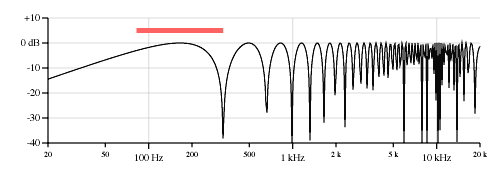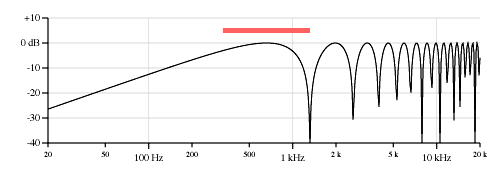
 |
|
#76
|
|||
|
|||
|
Quote:
Quote:
Try first the online generator, then provide constructive criticism. Some problems can be solved, some can not. I can not make "better" if I don't know what is the problem... Again "higher quality" is subjective. You can have a high quality made Gibson and a high quality made Martins, or Bourgeois... In the end, you might like one better than the other. Same thing applies to IR. Depending on the application, the best IR is different. Sorry Cuki
__________________
Martin 00-18V Goldplus + internal mic (2003) Martin OM-28V + HFN + internal mic (1999) Eastman E6OM (2019) Trance Audio Amulet Yamaha FGX-412 (1998) Gibson Les Paul Standard 1958 Reissue (2013) Fender Stratocaster American Vintage 1954 (2014) http://acousticir.free.fr/ |
|
#77
|
|||
|
|||
|
Actually, it looks like Audacity can use the LAConvolver AUUnit on Mac. That should at least give the possibility to get a better idea of how the IR filter behaves in different situations. I have no idea of the math behind this but if it's in any (and I do mean any!) way like modelling an arbitrary relationship with a cubic spline fit to a subset there can be rather unexpected deviations once you go beyond (or too much between) the original datapoints
 Audacity on Linux can also use plugins of a number of well-known technologies; if the IR is just a convolution kernel as I think there should be a way to load it in to a filter that knows how to apply them. I've just never seen a convolution kernel in a .wav file (but I should be able to call my Matlab/Octave knowledge back up and add an output handler for a different kind of format).
__________________
I'm always not thinking many more things than I'm thinking. I therefore ain't more than I am. Pickle: Gretsch G9240 "Alligator" wood-body resonator wearing nylguts (China, 2018?) Toon: Eastman Cabaret JB (China, 2022) Stanley: The Loar LH-650 (China, 2017) |
|
#78
|
|||
|
|||
|
I use Voxengo Boogex with Audacity on my Mac to audition my IRs. The IR/bypass mix control is “backwards” compared to an acoustic guitar pedal, but its convenient audition feature speeds eval.
__________________
jf45ir Free DIY Acoustic Guitar IR Generator .wav file, 30 seconds, pickup left, mic right, open position strumming best...send to direct email below I'll send you 100/0, 75/25, 50/50 & 0/100 IR/Bypass IRs IR Demo, read the description too: https://youtu.be/SELEE4yugjE My duo's website and my email... [email protected] Jon Fields Last edited by jonfields45; 03-04-2024 at 08:44 PM. |
|
#79
|
|||
|
|||
|
Quote:

__________________
I'm always not thinking many more things than I'm thinking. I therefore ain't more than I am. Pickle: Gretsch G9240 "Alligator" wood-body resonator wearing nylguts (China, 2018?) Toon: Eastman Cabaret JB (China, 2022) Stanley: The Loar LH-650 (China, 2017) |
|
#80
|
|||
|
|||
|
Well, I just tried it with the venerable Octave 4.2.2 I can run on my old Linux rig, and a 3min or so segment of a mic + PU recording I had of my archtop. Saved the patch at the highest quality output and applied it via LAConvolver, applied it to a few pure electric recordings ... and got a definitely worse-electric tone. I did reverse the channels to have the PU in the left, and the IR also doesn't make pure acoustic recordings sound electric so something else must be wrong
 (I do suppose you could do that if you wanted, make an acoustic sound like an electric or make a quality concert classical sound like Chet Atkins, by reversing the inputs?)
__________________
I'm always not thinking many more things than I'm thinking. I therefore ain't more than I am. Pickle: Gretsch G9240 "Alligator" wood-body resonator wearing nylguts (China, 2018?) Toon: Eastman Cabaret JB (China, 2022) Stanley: The Loar LH-650 (China, 2017) |
|
#81
|
|||
|
|||
|
1) The algorithm is not made to mimic another instrument
2) It is not appropriate with mag pickup You can not make the mag pickup of an arch top sound like an acoustic guitar with my algorithm If you want to do that (or be close) buy a Sim1 pedal https://sim1guitar.com The sim1 shapes the transient response of your instrument to match another My algorithm does not do that. If you don’t want to pay a sim1 pedal, read their patent and program your own plugin/pedal to do it. I would say it is a 6 months project. Maybe some extra time to make the pedal. (You don’t need to make a sim1 pedal… just to make the algorithm to capture the transient shaping parameters and program an IR pedal with a transient shaper).. see my older thread to make the IR pedal and you would just need to program the transient shaping function. here is the patent https://patentimages.storage.googlea...80122347A1.pdf
__________________
Martin 00-18V Goldplus + internal mic (2003) Martin OM-28V + HFN + internal mic (1999) Eastman E6OM (2019) Trance Audio Amulet Yamaha FGX-412 (1998) Gibson Les Paul Standard 1958 Reissue (2013) Fender Stratocaster American Vintage 1954 (2014) http://acousticir.free.fr/ Last edited by Cuki79; 03-05-2024 at 11:27 AM. |
|
#82
|
|||
|
|||
|
Quote:
The main difference between a magnetic PU and a piezo PU that I can think of is that the former gives a more lofi signal, so lacks all those higher harmonics (or parasites) which are responsible for the typical piezo quack (if I understood correctly). Is that the reason, that your algorithm is designed only to remove/reduce those higher harmonics?
__________________
I'm always not thinking many more things than I'm thinking. I therefore ain't more than I am. Pickle: Gretsch G9240 "Alligator" wood-body resonator wearing nylguts (China, 2018?) Toon: Eastman Cabaret JB (China, 2022) Stanley: The Loar LH-650 (China, 2017) |
|
#83
|
|||
|
|||
|
Quote:
https://till.com/articles/PickupResponse/ The frequency response of a pickup depends on its position AND on the string. Quote:
 Quote:
 Both curves are different, it means a magnetic pickup should have two different frequency correction for low E and high E strings... Same with all strings. You can not train one frequency response correction to do that. The algorithm will do its best... but will fail for sure. My IR algorithm can model the response of the top, the box and even air and some room reflexions... But not compensate the response of a magnetic pickup. In this case a Match EQ algorithm + a transient shaper is wiser to implement. my 2 cents, Cuki
__________________
Martin 00-18V Goldplus + internal mic (2003) Martin OM-28V + HFN + internal mic (1999) Eastman E6OM (2019) Trance Audio Amulet Yamaha FGX-412 (1998) Gibson Les Paul Standard 1958 Reissue (2013) Fender Stratocaster American Vintage 1954 (2014) http://acousticir.free.fr/ |
|
#84
|
|||
|
|||
|
Shifted in the frequency domain (at least theoretically), no?
Quote:
__________________
I'm always not thinking many more things than I'm thinking. I therefore ain't more than I am. Pickle: Gretsch G9240 "Alligator" wood-body resonator wearing nylguts (China, 2018?) Toon: Eastman Cabaret JB (China, 2022) Stanley: The Loar LH-650 (China, 2017) |
|
#85
|
|||
|
|||
|
Yes but all the strings contributions to the electric signal are sperposed... so you can not isolate them afterward.
That you could. There is a Roland/BOSS patent about the GR midi devices that describes the hexapickup compensation. But I don't remember which.
__________________
Martin 00-18V Goldplus + internal mic (2003) Martin OM-28V + HFN + internal mic (1999) Eastman E6OM (2019) Trance Audio Amulet Yamaha FGX-412 (1998) Gibson Les Paul Standard 1958 Reissue (2013) Fender Stratocaster American Vintage 1954 (2014) http://acousticir.free.fr/ |